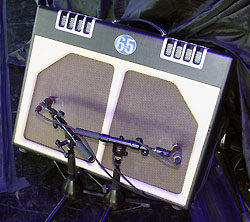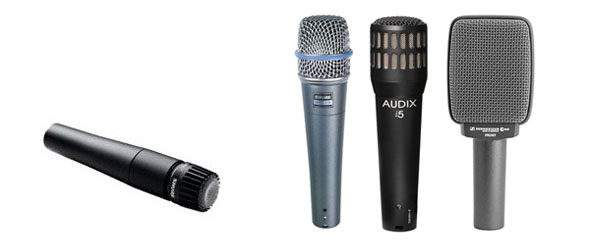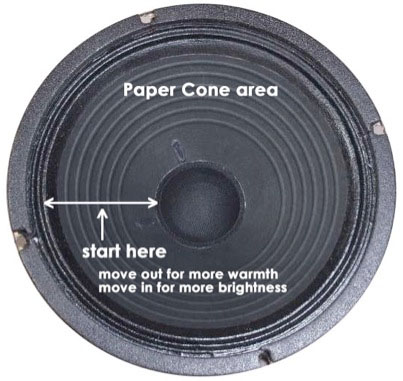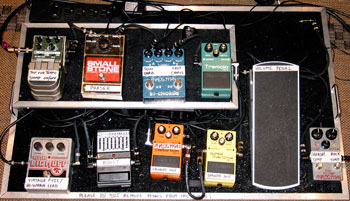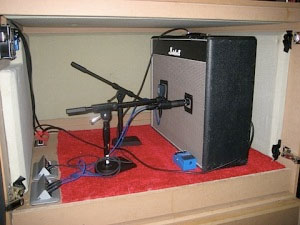Start by identifying the location of the speakers in the cabinet. Don’t assume that the speaker location is symmetrical (some are, some aren’t.)
You may need to look at the back of the cabinet or shine a flashlight through the grillcloth to locate the position of the drivers inside the cabinet.
Next, aim for the center of the paper cone, and about 1-2 inches from the grillcloth. This is the general starting place for all setups.
Adjustments will be made from this baseline, based on the sound desired and/or to fix problems.
WHICH MICROPHONE? There are quite a few choices these days. The baseline microphone for guitar amps is the Shure SM57. It will almost always work.
There are some other choices, such as the Shure Beta 57, Audix i5, and the Sennheiser e609. The Audix i5 has a more pronounced proximity effect, which might give you more low end if close-mic’d.
The Sennheiser e609 goes the other way, offering a less pronounced proximity effect if the amp is pretty bass-heavy already.
Beyond that, you have the more exotic and expensive choices of dynamic, large-diaphragm condenser and ribbon mics.

TONE TIPS: There are two ways to get more low frequency response:
1) Move the microphone closer to the grillcloth and take advantage of proximity effect, or
2) Move the microphone more to the outside of the paper cone area.
These tips also work in reverse for more brightness. You can also try angling the mic to see if the off-axis response might work to your favor.
It’s always better to try moving the mic rather than reaching for EQ though. Moving the mic a couple inches might dramatically change the sound, and still leave you some EQ options.
A pedal board can today’s guitarists achieve a wide variety of sounds.
PHILOSOPHY: We always start from the assumption that the musician knows their gear, knows what sound they are trying to achieve, and has adjusted their pedals, tone knobs, and gain structure to produce the sound they want.
So the primary goal here is to faithfully reproduce the sound that is coming out of the amplifier. Match tone first. Then improve if it needs it. Don’t just hang out in the booth during rehearsal. See what it sounds like coming out of the amp so you know what it should sound like coming out of the house.
WHAT IF THE TONE IS STILL LOUSY? Sometimes, especially with newer players who do not know their gear very well, you have the situation where the sound coming out of the amp is just not good. If, regardless of mic choice, mic placement, and tone adjustments in the booth, the electric guitar sound is still unusable in your opinion, then it is time to talk to the stage.
The first thing to do is to confer with the music director or band leader and let them make the call. Do not approach the musician directly unless you have a good personal relationship with them. In any case, very calmly explain the problem.
WHAT ABOUT VOLUME? If the stage volume is out of control, the first thing to determine with a player’s rig is if they are using the speaker cabinet as a monitor or as a tone-generator. For example, if they use a Line 6 Pod or other tone modeling device to achieve their sound, then the amp could just be used as a simple monitor, and lowering the volume will make everyone happy.
However, if they are using the tubes in the amp to achieve the desired tone, then it may be a tough sell asking them to lower the volume.
If that’s the situation, then you have to look at:
1) Changing the direction of the amp
2) Changing the location of the amp
3) Changing to a smaller amp
4) Utilizing one of the many “power attenuator” type devices on the market (such as the THD Hot Plate) to lower the cabinet volume
5) Building an iso-box for the amp
BONUS: Here’s how to build a isolation box to eliminate stage volume. (source: Buckhead Church)
For a whole lot more information on this topic, read Capturing Guitar Amps In The Wild.
Jeremy Carter is a veteran of the pro audio industry with extensive experience designing and operating church audio, video, and lighting systems. Learn more at Sound Sessions.


